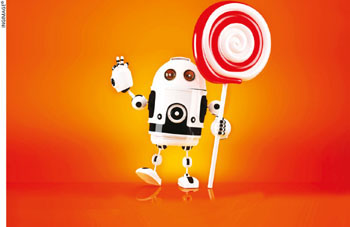DIGITAL SERVICES
SMART DINING OUT!
Ruwandi Perera wonders whether having robots serve us in restaurants is a good idea

Imagine going out to a restaurant, and being greeted by a robot and taken to your table on a conveyor belt… and then pressing a button on the table to see food appear. Sounds like something from a sci-fi movie or a mix of I, Robot and Hogwarts, doesn’t it?
Well, think again… because while you may not face the scenario described above, a similar situation awaits you thanks to smart restaurants that are sprouting more rapidly than a chef can whip up a Caesar salad.
Restaurants have been around from the time of the ancient Romans. And with everything going digital, it isn’t surprising that the concept of eating out is headed that way too.
Although restaurants such as the Wild Robot Restaurant in Japan, Haohai Robot Restaurant in China and Hajime Restaurant in Thailand have robots bringing food to the table, they lie at the far extreme of smart eateries. On a more conceivable level are eateries that have adopted various elements of digitisation to provide speedier, more accurate and streamlined guest services.
Major chains such as Applebee’s have tablets on every table where guests can peruse the menu, order and pay their bills seamlessly. Although there’s a human element involved, the extent of interaction is reduced to serving food.
With no waiters or waitresses to greet customers, walk them to their table, make them feel comfortable and take orders, it may seem as though the smart restaurant concept is automating the process of eating out – not necessarily negatively, given that today’s diners tend to value speed, convenience and modernity above guest relations and small talk.
Nevertheless, fine dining will still be around where you will be waited upon and treated like royalty, and traditional restaurant etiquette will be followed to the last drop of vinaigrette. Smart restaurants are more for casual dining where speed and convenience are preferred over sophistication and personalised service.
With the emergence of a foodie culture and the growing trend of eating out, restaurants are even using smart technologies to manage waiting lists. Systems such as Nowait and NoshList ensure that customers are notified when their tables are ready, which eliminates the need to wait in long queues.
Moreover, there are a number of mobile apps in the market that allow customers to fast track to the eating stage at a restaurant by completing all time-consuming tasks before their arrival.
For instance, apps such as Allset help customers select a restaurant, browse through the picture menu, reserve a table, place an order, pay (including taxes and tips) and walk into the restaurant and proceed to eat upon identifying themselves. This may not be the best option for a first date (unless you’re planning to end the meal in half an hour!) but it’s definitely handy when you don’t have time to sit around and wait for your food to be prepared.
And if you’re one of those somewhat impatient customers who incessantly asks for updates on why an order is taking so long to prepare, apps such as RushOrder are ideal to keep a tab on the entire process with real-time notifications.
Not all restaurants will have pre-ordering services but an increasing number of them are transforming traditional restaurant services such as taking orders and accepting payments to include digital alternatives like ordering kiosks, touchscreen drive-through facilities and mobile payments.
Meanwhile, establishments such as Starbucks have taken the drive-through concept to the next level by installing large video screens at some of its outlets in the US. Customers can see their barista live, chat with them if they want to and have their coffee fix… or opt to do all of this less glamorously by pressing a few buttons!
Going smart expands the list of options for restaurants. Ever been out for sushi and wondered whether you really need to dip that nigiri roll in soy sauce? Now with restaurants having tablets and iPads displaying videos of how food is prepared and should be consumed, diners are informed and can avoid unwanted embarrassment.
The downside of all this (as with all smart solutions) is that there will be less demand for labour in restaurants. With fewer guest interactions needed, the role of waiters and waitresses will be limited to transporting food from the kitchen to the tables – if robots haven’t taken this over too.
This might also mean that restaurants can use technology at a comparatively low cost to cover simpler tasks, and utilise manpower in more strategically important roles like kitchen duties, meal planning and preparation.
With just about everything becoming smarter, quicker and digitised, the question arises as to whether restaurants will turn into glorified vending machines in the future.
Now that’s food for thought!



